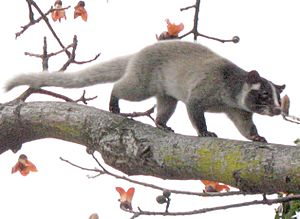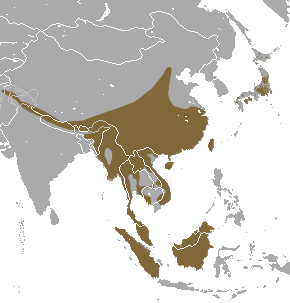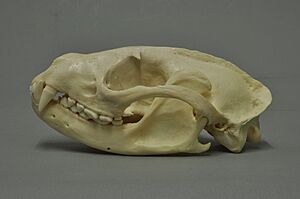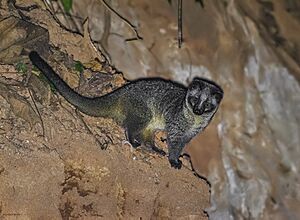Masked palm civet facts for kids
Quick facts for kids Masked palm civet |
|
|---|---|
 |
|
| Conservation status | |
| Scientific classification | |
| Genus: |
Paguma
|
| Species: |
larvata
|
 |
|
| Masked palm civet range | |
The masked palm civet (Paguma larvata) is a cool animal related to cats and mongooses. It is also known as the gem-faced civet or Himalayan palm civet. These animals live in parts of Asia, including India and Southeast Asia. Since 2008, experts have listed them as "least concern." This means there are lots of them, and they live in many protected areas. They can even live in places where humans have changed the habitat a bit.
The group of animals called Paguma was first named in 1831 by John Edward Gray. All the different types of masked palm civets are thought to be part of the same species. In 2003, scientists found that some masked palm civets in a wildlife market in China had a virus. This virus was later linked to the severe acute respiratory syndrome coronavirus.
Contents
What Masked Palm Civets Look Like
The masked palm civet has fur that can be grayish or yellowish-brown. Its head, shoulders, and neck are black. Its tail and feet are a dark brownish-black. It has a white stripe on its forehead, like a blaze. White marks are found above and below its eyes. These marks stretch to its ears, making a shape like a half-collar.
Masked palm civets look a lot like other palm civets. But they do not have spots or stripes on their fur. Their tail is very long, more than two-thirds the length of their head and body. Female civets have two pairs of mammae, which are used for feeding their young.
The white mask on their face spreads out to the sides of their cheeks. It also goes up their forehead, past their ears, and down the back of their neck. It stops just below their shoulder blades. White fur surrounds their eyes. This can be a faint outline or clear white patches. Their lips, chin, and throat are white. Some civets have white stripes of fur that curve up from their throat. These look a bit like human sideburns.
Masked palm civets live in many different places. Because of this, their size can vary a bit. Adult civets are usually about 50 to 60 centimeters (about 20 to 24 inches) long. Their tails are about 40 to 50 centimeters (about 16 to 20 inches) long. They usually weigh between 3 and 5 kilograms (about 6.6 to 11 pounds). Some adults can be a little lighter or heavier.
Where Masked Palm Civets Live
The masked palm civet lives in many places across Asia. You can find them in the northern parts of India, especially in the Himalayas. They also live eastward through Bhutan, Bangladesh, Myanmar, Thailand, Peninsular Malaysia, Laos, Cambodia, and Vietnam. Their range extends to China, Borneo, Sumatra, Taiwan, and the Andaman and Nicobar islands.
These civets have also been brought to Mainland Japan and the Ryukyu Islands. They live in both evergreen forests (where trees stay green all year) and deciduous forests (where trees lose their leaves). They can also live in areas where the forest has been changed by humans. They can even be found in small, separated forest areas.
In Japan, studies show that masked palm civets were brought there by people. This happened many times over hundreds of years. At least two groups of civets came from Taiwan.
How Masked Palm Civets Live
The masked palm civet is a night animal. This means it is most active at night. It usually lives alone. Sometimes, it can be seen active during the day. It is also partly arboreal, meaning it spends some of its time in trees.
When a masked palm civet feels scared, it sprays a special liquid. This liquid comes from a gland near its tail. The spray is like what a skunk does. It helps to scare away other animals that might try to hurt it.
What Masked Palm Civets Eat
The masked palm civet is an omnivore. This means it eats both plants and animals. It hunts for small animals like rats and birds. It also enjoys eating fruits such as figs, mangoes, and bananas. They also eat leaves. Scientists have studied their droppings to see what they eat. They found that civets also eat mollusks (like snails), arthropods (like insects), and tree bark. Sometimes, they eat snakes and frogs, but not as often. What they eat can change depending on the season and where they live.
Reproduction
Masked palm civets have two breeding seasons each year. A female civet can give birth to up to four young at a time. In zoos, masked palm civets have been known to live for up to 15 years. The young civets grow to the size of an adult in about three months.
Threats to Masked Palm Civets
The biggest dangers for masked palm civets are the loss of their homes and hunting. Their habitat destruction happens when forests are cut down or changed. People also hunt them for bushmeat, which is meat from wild animals. Masked palm civets are often sold in restaurants in southern China and are also eaten in Vietnam.
These civets are sometimes caught and sold illegally. This is called illegal animal trafficking. In April 2021, about 100 civets were rescued from this illegal trade. They were taken to a wildlife rescue center called Save Vietnam Wildlife. Sadly, at least 8 of these civets died because of stress and injuries.
Conservation Efforts
Paguma larvata is a protected animal in Malaysia and China. However, it is not protected in Thailand and Nepal. The masked palm civet population in India is listed under CITES Appendix III. This means that trade of these animals from India is controlled.
Connection with a Virus
In May 2003, a virus called SARS was found in several masked palm civets. These civets were at a wildlife market in Guangdong, China. The virus was also found in other animals, like a raccoon dog, and in people who worked at the market.
Later, in 2006, scientists from China and Hong Kong found a direct link between the SARS virus in civets and the SARS virus in humans. This showed that the disease had moved from animals to people.
See also





